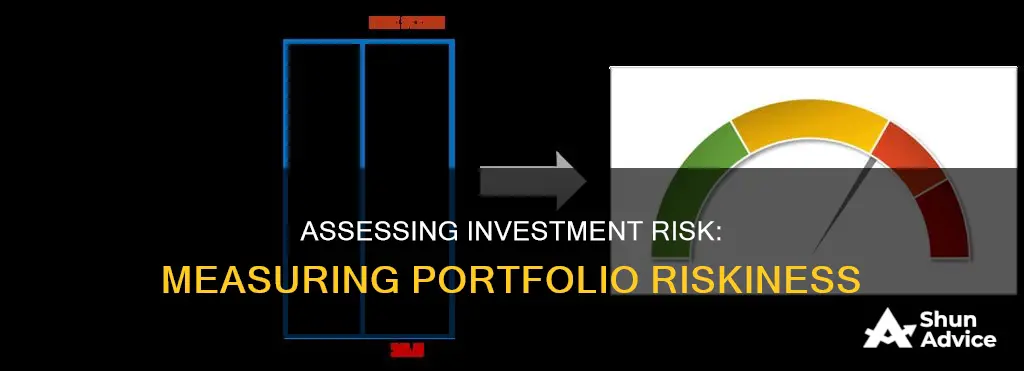
Risk is an inherent part of investing, and while it is difficult to define, it is important to understand how to measure it. This is especially true when investing in financial markets, where significant risks can lead to substantial losses. There are various ways to measure the riskiness of an investment portfolio, and investors need to be aware of these to make informed decisions. This involves understanding statistical measures and risk/reward models to differentiate between volatile and stable assets.
| Characteristics | Values |
|---|---|
| Alpha | Measures risk relative to the market or a selected benchmark index |
| Beta | Measures the volatility or systematic risk of a fund in comparison to the market or a selected benchmark index |
| R-squared | Measures the percentage of a fund's movement attributable to movements in its benchmark index |
| Standard Deviation | Measures the spread of returns around the average return |
| Sharpe Ratio | Measures performance as adjusted by the associated risks |
| Value at Risk (VaR) | Provides a worst-case scenario analysis |
| Conditional Value at Risk (CVaR) | Measures the expected loss should the loss be greater than the VaR |
| Duration | A measure of the effect of rising interest rates on the price of a bond |
| Correlation | Measures the strength of the relationship between the investment returns of two assets |
| Liquidity Risk | Unable to sell investments due to low market values |
| Concentration Risk | Risk of losing money by investing in only one type of asset |
| Credit Risk | Applicable for debt investments, the company issuing the bonds faces financial difficulties |
| Reinvestment Risk | Occurs in the event of declining interest rates |
| Horizon Risk | Forced to sell investments due to unforeseen events |

Alpha ratios
Alpha is a measure of an investment portfolio's performance, indicating whether it has managed to beat the market return or benchmark index over a certain period. It is often considered the active return on an investment and is used as a gauge for the performance of a strategy, trader, or portfolio manager.
Alpha is one of the five popular technical investment risk ratios, the others being beta, standard deviation, R-squared, and the Sharpe ratio. These statistical measurements are used in modern portfolio theory (MPT) to help investors determine the risk-return profile of an investment.
Alpha is the excess return of an investment relative to the return of a benchmark index. It can be positive or negative and is the result of active investing. A positive alpha indicates that a fund has generated returns better than its benchmark over a certain period, while a negative alpha points to underperformance relative to the market. For example, an alpha of 1 indicates that an investment's return over a given period was 1% higher than the benchmark. An alpha of zero would mean that the portfolio is tracking exactly with the benchmark index and that the manager has not added or lost any value compared to the broad market.
Alpha is calculated by subtracting the total return of an investment from a comparable benchmark in its asset category. It is important to compare similar asset investments when using this basic calculation of alpha. More advanced techniques, such as Jensen's alpha, take into consideration the capital asset pricing model (CAPM) and include a risk-adjusted component in their calculation.
Alpha can also refer to the abnormal rate of return on a security or portfolio in excess of what would be predicted by an equilibrium model like CAPM. In this case, alpha is the difference between the portfolio's actual return and the return predicted by CAPM.
In summary, alpha is a critical measure for investors to assess the performance of their investment portfolios relative to the market or a chosen benchmark. It helps identify whether the portfolio manager has added value through active investing strategies.
Savings, Investments, and the Economy's Vital Balance
You may want to see also

Beta ratios
Beta measures the volatility of a portfolio compared to a benchmark index, typically the broader market. It provides investors with a quick way to assess an investment's volatility compared to a benchmark. If a security's beta equals one, it moves in conjunction with the benchmark. Betas below one are considered less volatile than the benchmark, while those over one are considered more volatile.
Beta is calculated by dividing the covariance of the excess returns of an investment and the market by the variance of the excess market returns over the risk-free rate. It is important to note that beta only looks at a stock's past performance relative to the benchmark and does not predict future moves.
Beta is a useful tool for investors to gauge how much risk a stock adds to a portfolio. A stock with a beta of 1.0 means its price activity correlates with the market. Adding such a stock to a portfolio doesn't increase the risk, but it also doesn't enhance the potential for greater returns.
A beta value less than 1.0 indicates that the security is less volatile than the market. Including this type of stock in a portfolio reduces its overall risk compared to not having it. Utility stocks often have low betas because they tend to move more slowly than market averages.
On the other hand, a beta greater than 1.0 indicates that the security's price is theoretically more volatile than the market. If a stock's beta is 1.2, it is assumed to be 20% more volatile than the market. Technology stocks tend to have higher betas than the market benchmark. Adding such a stock to a portfolio will increase its risk but may also boost its potential returns.
Beta is a good indicator of short-term rather than long-term risk. It is a useful measure for traders who frequently buy and sell stocks within short periods. However, for investors with long-term horizons, beta is less useful as a stock's volatility can change significantly over time.
Investing vs. Saving: Brainly's Guide to Financial Strategies
You may want to see also

Standard deviation
Mathematically, standard deviation is calculated by taking the square root of the variance, which is the average of the squared differences from the mean. The formula for standard deviation in the context of investment portfolios is:
> √ [Σ(x - μ)² / N]
Where x = each value in the dataset, μ = the mean of the dataset, and N = the number of data points.
A high standard deviation indicates that the investment returns are highly variable and deviate significantly from the expected returns, implying higher risk and volatility. Conversely, a low standard deviation suggests that the returns are more stable and predictable, with less deviation from the average.
For example, consider a mutual fund with annual returns of 4%, 6%, 8.5%, 2%, and 4% over five years. The average return is 4.9%, and the standard deviation is 2.46%. This indicates that the fund's returns have been relatively consistent, with a low level of volatility.
Maximizing Savings: Strategies to Double Your Money
You may want to see also

Sharpe ratios
The Sharpe ratio is a statistical measure of the risk-adjusted return of a financial portfolio. It is one of the most referenced risk/return measures used in finance, largely due to its simplicity. The ratio was developed by Nobel laureate William F. Sharpe, and it is calculated by subtracting the risk-free rate of return from the expected rate of return, then dividing the resulting figure by the standard deviation.
The Sharpe ratio is calculated as follows:
Sharpe Ratio = (Rp – Rf) / Standard deviation
Rp is the expected return (or actual return for historical calculations) on the asset or the portfolio being measured.
Rf is the risk-free rate, which is often a U.S. Treasury bill of short maturity. However, some analysts suggest that the maturity of the Treasury bill should be similar to the duration of the investment(s) being measured.
A higher Sharpe ratio indicates better risk-adjusted performance. A ratio of 1 or better is generally considered good, while a ratio of 2 or better is very good, and a ratio of 3 or better is excellent.
For example, consider two portfolios: Portfolio A is expected to return 14% over the next 12 months, while Portfolio B is expected to deliver an 11% return over the same period. Without considering risk, Portfolio A appears to be the better choice. However, when risk is factored in, Portfolio A has a standard deviation of 8% (indicating more risk), while Portfolio B has a standard deviation of 4% (indicating less risk). Assuming a risk-free rate of 3%, Portfolio A has a Sharpe ratio of 1.38, while Portfolio B has a Sharpe ratio of 2. Thus, despite the lower expected returns, Portfolio B provides superior risk-adjusted returns.
It is important to note that the Sharpe ratio assumes that an investment's average returns follow a normal distribution, which is not always the case in the real world of financial markets. Additionally, the Sharpe ratio does not account for the direction of volatility, treating upside and downside volatility equally.
Saving and Investment Economics: Core Concepts Explained
You may want to see also

Value at Risk (VaR)
VaR is calculated based on three variables: time period, confidence level, and predetermined loss amount. For example, a portfolio with a one-year 10% VaR of $5 million indicates a 10% chance of losing $5 million over a one-year period. VaR provides investors with a worst-case scenario analysis, helping them assess the likelihood of specific outcomes.
There are three main methods for computing VaR: the historical method, the variance-covariance method, and the Monte Carlo method. The historical method involves ordering historical returns from worst to best and assuming that past returns will inform future outcomes. The variance-covariance method assumes that gains and losses are normally distributed, allowing potential losses to be framed in terms of standard deviation from the mean. The Monte Carlo method uses computational models to simulate projected returns over numerous iterations, providing insights into the likelihood and impact of losses.
While VaR is widely used, it has some limitations. It does not provide information about the severity of losses beyond the VaR threshold and can underestimate risk during periods of market stress or for assets with abnormal return distributions. Additionally, different calculation methods can yield varying results for the same portfolio.
Despite its limitations, VaR is a valuable tool for risk managers as it enables them to measure and control the level of risk exposure. It assists in making strategic investment decisions and allocating risk based on the assessed riskiness of a portfolio.
Understanding Investment Strategies: Model Portfolios Explained
You may want to see also







